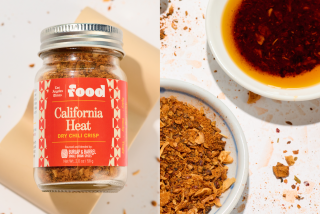Spice Rubs : On the Spice Trail
- Share via
I know a Frenchwoman who refuses to eat any dish with two spices in it, unless they’re pepper and nutmeg. More than two spices, absolument no way. This French disdain for spices is a relatively recent thing, though. Until about 300 years ago, the French were throwing spices around with a free hand just like everybody else in Europe.
Like most of the world, in fact. Chinese cooks have their five-spice mixture, the Near East its twabil and harisa mixtures, and the mind reels at all the masala and bumbu combinations used in spice-growing countries such as India and Indonesia. Back in Roman times, the 2nd-Century cookbook “De Re Coquinaria “ called over and over for pepper and caraway, or pepper, cumin and coriander. Even the plainest American cooking uses pickling spice, and I don’t want to push my French acquaintance on this, but most French sausages are flavored with something called quatre-epices (that means four spices, cherie ).
True, Europe sort of went overboard about spices in the Middle Ages. In 1420, Maistre Chiquart, major domo of the Duke of Savoy, proclaimed that a royal feast--to be attended by hundreds of guests, of course--absolutely required 640 pounds of the “major” spices (cinnamon, pepper, two kinds of ginger and a cousin of black pepper known as grain of paradise), plus six pounds apiece of nutmeg, mace, cloves and galingale (a cousin of ginger).
You would have to have been royalty to afford hundreds of pounds of spices in those days. But cost didn’t stop people, even in pretty remote places. Iceland is way out in the Atlantic and so far north it actually bumps up against the Arctic Circle. Any spices must have been fantastically expensive by the time they got there, but a 13th-Century cookbook from Iceland calls for imported spices in 17 of its 35 recipes. One dish alone specifies cloves, nutmeg, ginger, cinnamon, pepper and cardamom.
*
Being so expensive, spices were a way of displaying your wealth and showing honor to your guest. Spices were not , however, a way of masking the smell of spoiled meat--that idea was dreamed up by historians in the 18th Century. (Trust me. I’ve tried masking spoiled meat with spices, and it really doesn’t work.) The ultimate reason medieval people used a lot of spices was probably that they just liked them.
Medieval European cooks had a standard hot spice combination known as poudre fort , usually consisting of black pepper, cubeb (another of the medieval cousins of pepper), cloves, ginger and galingale. Its sweet counterpart was poudre douce : cinnamon, cardamom, coriander and mace. Recipes also call for spice combinations sold in the market, such as poudre Lombard and poudre marchant.
Certain French and Italian sauces were basically spice mixtures stretched out with almonds or breadcrumbs and vinegar--you could buy them readymade by the quart. The most famous was cameline sauce, based on ginger and cinnamon plus cloves or other spices. In Spanish recipes, salsa fina wasn’t at all what we think of as a sauce but a mixture of spices, usually ginger, cinnamon, pepper, cloves, mace, nutmeg and saffron.
The recados used in Mexico today call for many of these Old World spices, and we can assume that they’re descended in one way or another from the medieval European poudres. But there are big differences. Ginger rarely, if ever, figures in Mexican spice mixtures, though it was one of the most popular spices in medieval Europe (because it was the cheapest imported spice). And a high proportion of the Mexican spice mixtures call for cumin--for many people, cumin is the flavor of Mexican food--but cumin was rarely used in medieval Europe.
*
Cumin had been the Romans’ second favorite spice, right after pepper. In the aforementioned 2nd-Century Roman cookbook, it shows up in more than 80 recipes, including most vegetable recipes and a couple of surprises such as stewed apricots. But while the ancient Romans liked hot spices such as cumin, caraway, mustard and asafetida, the medieval taste was for perfumy spices such as cinnamon, clove, mace and nutmeg, which aren’t even mentioned in the Roman cookbook.
Even the Arabs of Spain, heirs of a separate cooking tradition, didn’t use a whole lot of cumin. Interestingly, when they did, the cumin was usually accompanied by coriander, a spice combination popular not only in ancient Rome but in India. The combination of cumin and coriander is found in the Yucatecan annatto paste recado de adobo colorado , but otherwise it’s relatively uncommon in Mexico.
So where did Mexican cooks come up with the combination of cumin, cinnamon and clove, found so often in their cookery? It’s as if they replaced the ginger in cameline sauce with cumin. But why?
Quien sabe? Maybe they just liked it.


